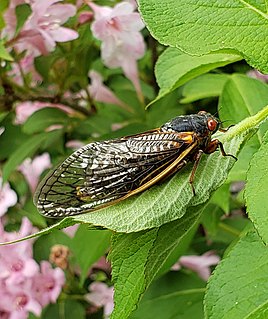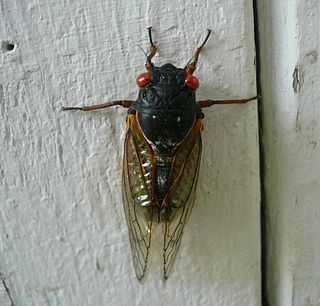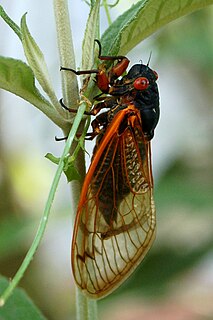
The cicadas are a superfamily, the Cicadoidea, of insects in the order Hemiptera. They are in the suborder Auchenorrhyncha, along with smaller jumping bugs such as leafhoppers and froghoppers. The superfamily is divided into two families, Tettigarctidae, with two species in Australia, and Cicadidae, with more than 3,000 species described from around the world; many species remain undescribed.

Pehr Kalm, also known as Peter Kalm, was a Finnish explorer, botanist, naturalist, and agricultural economist. He was one of the most important apostles of Carl Linnaeus.

Brood X, the Great Eastern Brood, is one of 15 broods of periodical cicadas that appear regularly throughout the eastern United States. It has the greatest range and concentration of any of the 17-year cicadas.

Magicicada is the genus of the 13-year and 17-year periodical cicadas of eastern North America, consisting of seven species. Although they are sometimes called "locusts", this is a misnomer, as cicadas belong to the taxonomic order Hemiptera, suborder Auchenorrhyncha, while locusts are grasshoppers belonging to the order Orthoptera. Magicicada belongs to the cicada tribe Lamotialnini, a group of genera with representatives in Australia, Africa, and Asia, as well as the Americas.

Brood XIII is one of 15 separate broods of periodical cicadas that appear regularly throughout the midwestern United States. Every 17 years, Brood XIII tunnels en masse to the surface of the ground, mates, lays eggs, and then dies off in several weeks.

Brood XIX is the largest brood of 13-year periodical cicadas, last seen in 2011 across a wide stretch of the southeastern United States. Periodical cicadas are often referred to as "17-year locusts" because most of the known distinct broods have a 17-year life cycle. Brood XIX is one of only three surviving broods with a 13-year cycle. It is also notable because it includes four different 13-year species, one of which was discovered in Brood XIX in 1998 by scientists listening to cicada songs.

Magicicada cassinii, sometimes called the 17-year cicada, Cassin's periodical cicada or the dwarf periodical cicada, is a species of periodical cicada. It is endemic to North America. It has a 17-year lifecycle but is otherwise indistinguishable from the 13-year periodical cicada Magicicada tredecassini. The two species are usually discussed together as "cassini periodical cicadas" or "cassini-type periodical cicadas." Unlike other periodical cicadas, cassini-type males may synchronize their courting behavior so that tens of thousands of males sing and fly in unison. The species was first described by Margaretta Morris. However, the specific name cassinii was in honour of John Cassin, an American ornithologist.

Magicicada septendecim, sometimes called the Pharaoh cicada or the 17-year locust, is native to Canada and the United States and is the largest and most northern species of periodical cicada with a 17-year lifecycle.

Massospora cicadina is a fungal pathogen that infects only 13 and 17 year periodical cicadas. Infection results in a "plug" of spores that replaces the end of the cicada's abdomen while it is still alive, leading to infertility, disease transmission, and eventual death of the cicada.

Aleeta curvicosta is a species of cicada, one of Australia's most familiar insects. Native to the continent's eastern coastline, it was described in 1834 by Ernst Friedrich Germar. The floury baker is the only described species in the genus Aleeta.
Magicicada neotredecim is the most recently discovered species of periodical cicada. Like all Magicicada species, M. neotredecim has reddish eyes and wing veins and a black dorsal thorax. It has a 13-year life cycle but seems to be most closely related to the 17-year species Magicicada septendecim. Both species are distinguished by broad orange stripes on the abdomen and a unique high-pitched song said to resemble someone calling "weeeee-whoa" or "Pharaoh." They differ only in life cycle length.
Magicicada tredecim is a 13-year species of periodical cicada, closely related to the newly discovered 13-year species Magicicada neotredecim, from which it differs in male song pitch, female song pitch preferences, abdomen color, and mitochondrial DNA. Both M. tredecim and M. neotredecim are closely related to the 17-year species M. septendecim, which was identified by Linnaeus in 1758; these three species are often grouped together under the name decim periodical cicadas.

The Cassini periodical cicadas are a pair of closely related species of periodical cicadas: Magicicada cassinii, having a 17-year lifecycle, and Magicicada tredecassini, a nearly identical species with a 13-year lifecycle.

Magicicada tredecassini is a species of periodical cicada endemic to the United States. It has a 13-year lifecycle but is otherwise indistinguishable from the 17-year periodical cicada Magicicada cassini. The two species are usually discussed together as "cassini periodical cicadas" or "cassini-type periodical cicadas." Unlike other periodical cicadas, cassini-type males may synchronize their courting behavior so that tens of thousands of males sing and fly in unison.
Brood XXII is a brood of 13-year periodical cicadas, last seen in 2014 in a geographic region centered on Baton Rouge, Louisiana, as well as other locations in southeast Louisiana and southwest Mississippi. Periodical cicadas are often referred to as "17-year locusts" because most of the known distinct broods have a 17-year life cycle. Brood XXII is one of only three surviving broods with a 13-year cycle. The next emergence of The Baton Rouge Brood is expected in 2027.
Brood XI was a brood of periodical cicadas that appeared regularly in the eastern United States. It was one of the smallest 17-year broods, consisting exclusively of the species Magicicada septendecim, and was historically restricted to areas of Connecticut, Massachusetts, and Rhode Island which appeared to be at the northern limit of the species' range. Brood XI has not been seen since its 1954 emergence and is now generally regarded as extinct.

Brood V is one of twelve extant broods of periodical cicadas that emerge as adults once every 17 years in North America. They are expected to appear in the eastern half of Ohio, the southwestern corner of Pennsylvania, the upper two-thirds of West Virginia less the Eastern Panhandle, far western Maryland, and some places in Virginia abutting West Virginia. Also included in Brood V is a population that emerges in Suffolk County, Long Island, New York. They last emerged in 2016, and their next appearance will be in 2033.

Reinforcement is a process within speciation where natural selection increases the reproductive isolation between two populations of species by reducing the production of hybrids. Evidence for speciation by reinforcement has been gathered since the 1990s, and along with data from comparative studies and laboratory experiments, has overcome many of the objections to the theory. Differences in behavior or biology that inhibit formation of hybrid zygotes are termed prezygotic isolation. Reinforcement can be shown to be occurring by measuring the strength of prezygotic isolation in a sympatric population in comparison to an allopatric population of the same species. Comparative studies of this allow for determining large-scale patterns in nature across various taxa. Mating patterns in hybrid zones can also be used to detect reinforcement. Reproductive character displacement is seen as a result of reinforcement, so many of the cases in nature express this pattern in sympatry. Reinforcement's prevalence is unknown, but the patterns of reproductive character displacement are found across numerous taxa, and is considered to be a common occurrence in nature. Studies of reinforcement in nature often prove difficult, as alternative explanations for the detected patterns can be asserted. Nevertheless, empirical evidence exists for reinforcement occurring across various taxa and its role in precipitating speciation is conclusive.

Allochronic speciation is a form of speciation arising from reproductive isolation that occurs due to a change in breeding time that reduces or eliminates gene flow between two populations of a species. The term allochrony is used to describe the general ecological phenomenon of the differences in phenology that arise between two or more species—speciation caused by allochrony is effectively allochronic speciation.
Massospora is a genus of fungi within the order Entomophthorales of the Zygomycota. It includes more than a dozen obligate, sexually transmissible pathogenic species that infect adult gregarious cicadas (Hemiptera) worldwide. At least two species are known to produce psychoactive compounds during infection.














